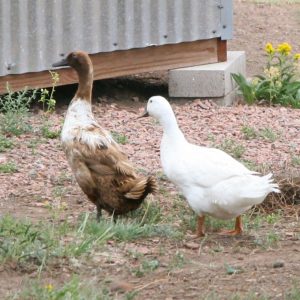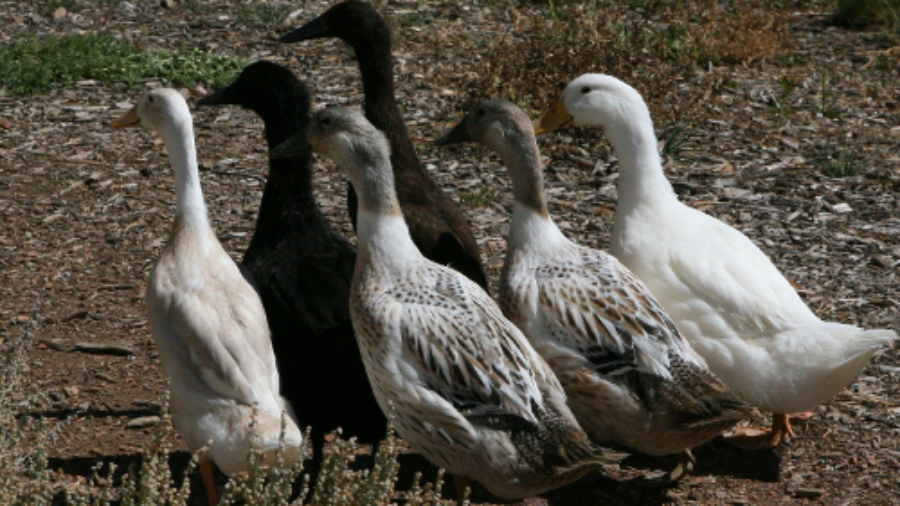
Our “Six-Pack” of ducks from 2016 is no longer with us. For various reasons, we have culled the flock one by one. Most of them were removed because they had stopped laying eggs, or laid only soft-shell eggs. We began raising our small, 2019 flock of ducklings while we still had two remaining “big ducks” from 2016, but in short time they were culled because they were just too crabby and no fun to have around.
Coco (Chocolate Runner) spent most of her waking hours hunched up with her feathers ruffled, quacking-quacking-quacking. Most of the time she looked like the right photo. It was unbearable.

Our other adult, Whitey, had been our best layer and generally a calm duck. But, after we’d culled two others, leaving just Coco & Whitey, Whitey began to quack just as much as Coco. Thinking Coco had infected her with crabbiness, we got rid of Coco first and attempted to calm Whitey down. Tim would sit on the ground to feed her out of a bowl located by his lap. At first, she would continue to quack and go hungry, because she was unwilling to come near. We tried holding her in our laps until she calmed down. A couple of days after starting this process, she was much quicker to come and eat quietly. There was some improvement, and we hoped she would return to being her calmer self, but even after a few days it just didn’t help calm her down. Whenever we would walk nearby or past her even at some distance, she would still quack like crazy. It just wasn’t worth the effort to continue working with her, not knowing if our efforts would calm her down.
With the baby ducklings growing, we decided to cut our losses with the old, and bring up the new flock without their influence. We are hoping these new ducks will be happier, quieter, calmer.




 With these cold temperatures the water does freeze, and winter adjustments need to be made. There are different ways of keeping the water liquid. My best solution is to keep a water heater in the bowl. It is on a timer, and usually turns on around 3am, so they will have water to drink in the morning. I turn it on occasionally during the day if the water is freezing, just for an hour or two off and on. The timer we have makes it easy to adjust like that. We keep our bowl on a raised platform over a hole in the ground, covered with hardware cloth. Normally the water will slowly drain from the hole into the earth. In winter this hole fills up with ice and never melts, so I need to be careful to empty the bowl without spilling more water into (onto) this hole. Recently I got out the flame thrower, melted the ice under the bowl as much as I could without burning the frame, then raised the bowl off the frame with an additional support to keep it from freezing onto the frame. I’ve found it’s helpful to keep all snow cleared from around the bowl as soon as possible. If not done, it quickly ices up and makes it nearly impossible to lift the bowl for emptying and refilling.
With these cold temperatures the water does freeze, and winter adjustments need to be made. There are different ways of keeping the water liquid. My best solution is to keep a water heater in the bowl. It is on a timer, and usually turns on around 3am, so they will have water to drink in the morning. I turn it on occasionally during the day if the water is freezing, just for an hour or two off and on. The timer we have makes it easy to adjust like that. We keep our bowl on a raised platform over a hole in the ground, covered with hardware cloth. Normally the water will slowly drain from the hole into the earth. In winter this hole fills up with ice and never melts, so I need to be careful to empty the bowl without spilling more water into (onto) this hole. Recently I got out the flame thrower, melted the ice under the bowl as much as I could without burning the frame, then raised the bowl off the frame with an additional support to keep it from freezing onto the frame. I’ve found it’s helpful to keep all snow cleared from around the bowl as soon as possible. If not done, it quickly ices up and makes it nearly impossible to lift the bowl for emptying and refilling. 





